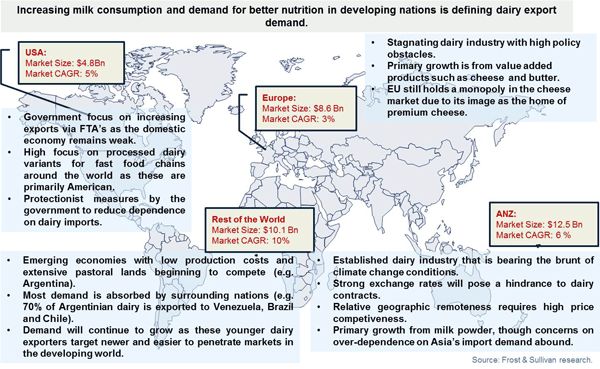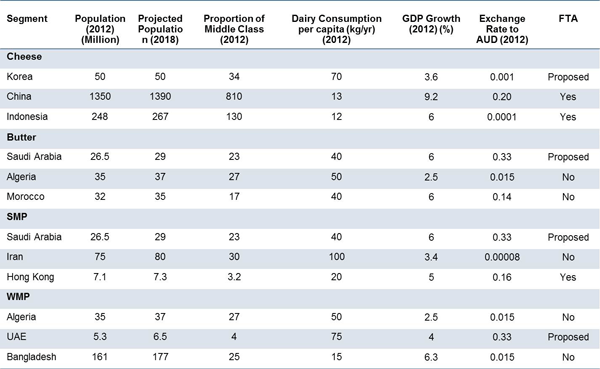By Natasha Telles D’Costa, research manager, New Zealand GIC, Frost & Sullivan
As global markets witness a paradigm shift with the economic recession, the dairy industry in all major producing countries has been called upon to provide much needed industry growth – particularly in the export field. No region however has managed to emulate the success story that is that of New Zealand in terms of establishing a flourishing dairy industry.
However, as global importers such as the USA seek to drastically reduce imports and in fact invest in exports, New Zealand’s position as the top dairy exporting country in the world is dependent on the country’s ability to foresee the trends arising in the dairy export industry. Growth will continue only if exporters begin to move beyond the traditional market channels and look at emerging markets and nascent product categories. Such a focus one that is already being put into action will be the key decider in the continued growth of an industry that literally affects the bread and butter of the Kiwi lifestyle.
The New Zealand dairy industry
The New Zealand dairy industry is the largest contributor to the country’s exports – accounting for around 25.0 percent of total exports. While NZ milk production accounts for only around two percent of the world’s production, New Zealand is the third largest dairy exporter, with almost 95.0 percent of its production going into exports. Additionally with no subsidies on dairy products and a strong co-operative system, the New Zealand dairy industry is one of the most competitive dairy industries in the world.
Traditionally the strategy that has worked for NZ has been its focus on Free trade agreements (FTAs) with large dairy importers such as China and the ASEAN. However, with the onset of the economic crisis, demand patterns have changed as the country sees increased demand from newer customers such as those in Africa, the Middle East and Latin America. While large existing partners develop their own dairy industries and try to reduce imports, it is these new markets that are likely to become strong export revenue generators in the future. The New Zealand dairy export market is expected to grow from $9.4 billion in 2011 to $13.5 billion in 2018, at CAGR revenue of 5.4 percent.
Existing export markets
China: New Zealand exports are largely dependent on China – a traditionally non-dairy consuming nation. In 2012 China accounted for 26 percent of all NZ whole milk powder exports. China has quickly emerged as the world’s largest importer of WMP, spurred by an increasingly affluent population and huge safety concerns in relation to domestic milk powder. New Zealand milk powder occupies the bulk of the Chinese market post the melamine scare in 2008, which saw exports to China skyrocket. The melamine scare turned into a huge opportunity for New Zealand milk powder as most countries that typically bought Chinese milk powder (such as Singapore and Vietnam) started to import from New Zealand, thereby causing a huge rise in revenues from 2009 to 2011.
New Zealand is considered a top quality importer in China and specific demand exists solely for New Zealand milk powder, a large amount of which is used to produce yoghurt – another growing market in China being spurred by the growth in demand for health foods. Imports have peaked post the melamine scandal and will continue to grow as newer scandals (such as the use of industrial leather grade gelatine additives in local products) sustain consumer fears. However, the extent of New Zealand’s dependence on China has cautioned manufacturers who prefer not to put all their eggs in one basket and it is this thought process that is causing a changing dynamic in the global export dairy market.
Emerging dairy export markets
The emerging markets differ based on dairy products but three nations have stood out overall as key demand economies.
Algeria: The Northern African countries of Algeria, Egypt, Tunisia and Libya have a combined population of 163 million (almost 30.0 percent of Europe) and an overall per capita dairy consumption of 117.3kg/year. Dairy demand is expected to grow at a CAGR of 20.0 percent until 2018. Algeria produces around 1.5 million MT of milk per year, but the lack of adequate infrastructure and frequent droughts have resulted in a huge discrepancy between production and collection. Europe, while still the major exporter, has steadily been losing import market share to New Zealand due to higher prices. The Algerian government, which runs the dairy industry, introduced subsidies to aid local manufacturers. However, this has not managed to reduce milk prices due to high input costs. Algeria has witnessed a growing demand for processed dairy products; especially cheese variants. In spite of local efforts, processing of dairy will continue to be an import dependent market and is one that is considered a key growth area by all major dairy exporters. New Zealand currently accounts for 40 percent of total Algerian dairy exports and this share is expected to continue to grow.
Korea: Beginning as a ‘western’ food, dairy products in Korea have quickly emerged as a key demand area, with consumption per capita rising to 70kg in 2012.The Korean domestic dairy industry primarily caters to local markets, accounting for 50.0 percent of consumption. Non-fluid consumption has risen from less than 10.0 percent in the 1970s to equal that of fluid consumption in 2011. However, most non-fluid dairy consumption used to produce dairy products are based on imports which account for 35.0 percent of non-fluid consumption. With two severe winters in 2010 and 2011, Korean dairy herds have lost livestock, resulting in a further decrease in production as the government plans to import more cattle to satisfy demand. Imports will continue to remain the main support to the dairy industry. However, with Korea’s new FTA with the USA a significant change in import destinations is expected; at the cost of ANZ exporters who are faced with a lack of subsidies, rising exchange rates and aggressive US marketing. As a result, ANZ will see significant drops in demand for their products, unless action is taken.
UAE: With increased westernisation, the UAE is an emerging dairy market that has seen consumption, particularly of processed dairy products, skyrocket since 2002.
The country is among the most westernised of the six nations that make up the GCC – a fact that has been underlined by its increasing imports. The UAE primarily produces fresh milk, laban and yoghurt (around 20.0 percent of total demand) for domestic consumption and exports to neighbouring countries. Very little is actually processed into dairy products and the country thus is highly dependent on imports to satisfy its demand of over 200,000 MT of dairy products per year. ANZ, primarily New Zealand, has taken over from Europe as the favoured supplier of dairy imports, particularly which of milk powder (where ANZ has emerged a clear favourite in spite of the EU being closer geographically). With limited local production and high dependence of other GCC nations, the demand for dairy imports from the UAE will continue to grow.
The way forward
As global dairy markets continue to compete aggressively, key strategies employed would hinge on two major trends, health and value addition. As players aim to provide more high value products by moving downstream, the focus on healthy dairy profiles will continue to increase. For example, skimmed milk powder is already witnessing high demand rates due to its reputation for being a healthy alternative to whole milk and its formulation efficiency in yoghurts and infant powders. Similarly regions countries such as Algeria, UAE and Venezuela will also provide new avenues for growth of New Zealand exports as these countries have hardly any domestic dairy processing and depend on New Zealand skim powder imports to process their dairy products, while Iran has emerged as a key purchaser of New Zealand butter. The global dairy market is being redefined and New Zealand is well poised to take full advantage of these new demand markets as a quality provider of all things good and great in dairy.






























































































